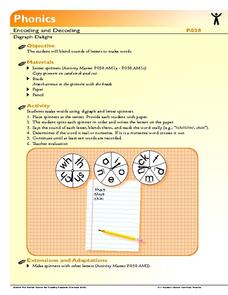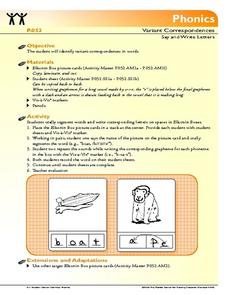Florida Center for Reading Research
Phonics: Encoding and Decoding, Digraph Delight
There are three spinners to use in this phonic activity. Spinner one contains digraphs, spinner two contains vowels, and spinner three contains consonants. Learners spin each spinner, write down the letters they get, blend them to make a...
Florida Center for Reading Research
Phonics: Letter-Sound Correspondence, Photo Chart
Have fun with student photographs in this phonics activity! Learners sort their classmates' photos by initial sound on a large poster board with the alphabet written vertically down the left side. Also provided are various pictures...
Florida Center for Reading Research
Phonics: Letter-Sound Correspondence, Where's That Sound?
The phoneme train is leaving the station! Get your budding readers familiar with letter-sound correspondence using this fun phonics activity. Learners set up the initial and final sound train cards, placing letters between them. They...
Florida Center for Reading Research
Advanced Phonics: Morpheme Structures, Compound Construction
A phonics lesson focuses on morpheme structures—compound words. Pairs choose letter cards, identify a compound word that starts with that letter and write it on a whiteboard. Extension opportunities include additional practice pages.
Florida Center for Reading Research
Advanced Phonics: Syllable Patterns, Syllable Game
A game designed to support advanced phonics instruction challenges scholars to read and break a word into syllables. If the player is correct, they move their game piece forward on the board. Whoever gets to the end first wins!
Texas Center for Learning Disabilities
Second and Third Grade Explicit Phonics Intervention
Support all young learners on their journey to literacy with this five-lesson reading intervention unit. Following a clearly outlined format, each lesson first engages children in practicing their phonemic awareness and phonics skills...
Florida Center for Reading Research
Phonics: High Frequency Words, Memory Word Game
Play this fun adaptation of the game Memory. Young scholars flip over high-frequency word cards, read them aloud, and keep them if they match.
Florida Center for Reading Research
Phonics: Letter-Sound Correspondence, Letter-Sound Bingo
Young scholars build a strong understanding of medial sounds, vowels, and letter sound correspondence while playing Bingo. Taking turns, peers choose a card and say its name and medial sound; all players look for the vowel on their card....
Florida Center for Reading Research
Phonics: Letter-Sound Correspondence, Medial Phoneme Spin
A collaborative activity challenges young scholars to match medial graphemes and phonemes. Pairs take turns spinning the spinner, naming the letter, and saying its name. They choose from a stack of cards with the same medial sound.
Florida Center for Reading Research
Phonics: High Frequency Words, Word Baseball
Scholars play high-frequency word baseball, pretending to be a pitcher and a batter. Players take turns choosing baseballs with high-frequency words printed on them. If they read the word correctly, they move to the next base until they...
Florida Center for Reading Research
Phonics: Letter-Sound Correspondence, Letter-Sound Pyramid
This fun game is a way to help your littlest learners build strong phonological awareness. Scholars equipped with letter triangles, a stack of picture cards, and counters choose a picture card, say the name of the image, and attempt to...
Florida Center for Reading Research
Phonics: Onset and Rime, Word-Roll-A-Rama
Learners roll two die; die one contains various onsets, and die two contains different rimes. They write down the onset and rime pair they get, then blend and read their word.
Florida Center for Reading Research
Phonics: Encoding and Decoding, Letter Cube Blending
Emergent readers use a letter cube to identify, blend, and make words. They roll each of the three-letter cubes, mark down the letters they rolled, then blend the letter sounds together to make a word. They record each word on a...
Florida Center for Reading Research
Phonics: Encoding and Decoding, Three-In-One
Scholars use the provided pack of alphabet cards to construct basic CVC words, then write down each word they make in one of two columns. Column one is for real words and column two is for nonsense words.
Florida Center for Reading Research
Phonics: High-Frequency Words, Word Fishing
To practice reading high-frequency words fluently, learners play a fishing game at a learning center. They take turns fishing; each fish contains a single high-frequency word. To keep the fish they caught, they must be able to read the...
Florida Center for Reading Research
Phonics: Letter Recognition, Clip-A-Letter
Young scholars show what they know about the alphabet. With two circles—one surrounded by capital letters and one with lowercase—pupils use clothespins to match letters, case to case or the opposite.
Florida Center for Reading Research
Phonics: Letter-Sound Correspondence, Letter-Sound Folder Sort
Practice letter-sound correspondence using an activity that challenges pupils to sort images based on their final sounds. Pairs choose four final sounds to place in an open file folder, take turns selecting image cards, pronouncing the...
Florida Center for Reading Research
Phonics: Letter-Sound Correspondence, Letter Sound Match
Scholars match initial, medial, and final phonemes to individual graphemes. They pick a card, say its name, then find the letter that makes that sound. If the card is a monkey, the learner finds the letter m, matching the grapheme to the...
Florida Center for Reading Research
Phonics: Onset and Rime, Word Maker Game
Scholars use a set of onset and rime cards to construct and write various simple words. Pairs take turns pulling cards from a bag and blending the onset card with the rime card to create a word. They record the onset, the rime, and the...
Florida Center for Reading Research
Phonics: Encoding and Decoding, A Digraph A Word
Learners view a series of images, then choose digraphs, consonants, and vowels to spell out the object's name on each card.
Florida Center for Reading Research
Phonics: Varient Correspondances, Silent "e" Changes
Engage early readers in a silent e activity to help them understand the changes the letter can make to a simple word. With the provided cards, learners read and write each word as it appears without the silent e. Then they read and write...
Florida Center for Reading Research
Phonics: Variant Correspondences, Say and Write Letters
Scholars sound out and write twelve different words. Using Elkonin boxes, pupils say the name of each picture, then write the letters that make each sound.
Florida Center for Reading Research
Phonics: High Frequency Words, Word Bowling
Go bowling for high-frequency words! Partners take turns drawing bowling ball cards and read the word printed on them. If the learner is successful, they record their score on a scorecard.
Florida Center for Reading Research
Phonics: Onset and Rime, Say It Now
Pairs use onset and rime cards to make as many words as possible by blending the onsets with the rimes.
Other popular searches
- Teaching Phonics
- Phonics Worksheets
- Phonics Blends
- Phonics Lesson Plans Vowels
- Phonics Lesson Plans
- Phonics Rules
- Phonics Games
- Phonics Worksheets Oi Oy
- Phonics Lessons
- Phonics Activities
- Phonics /Ch/
- Phonics Games Short Vowels

























